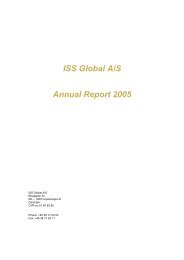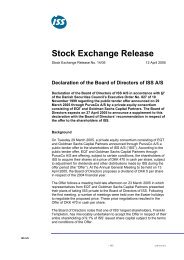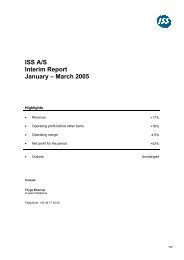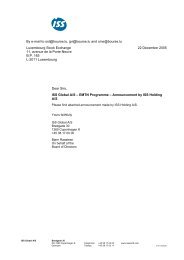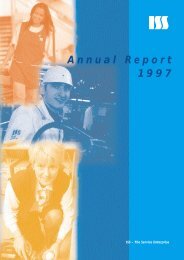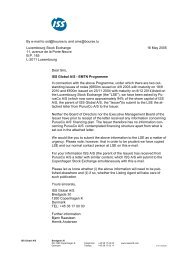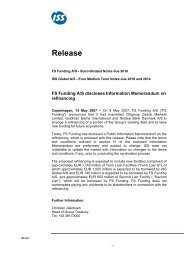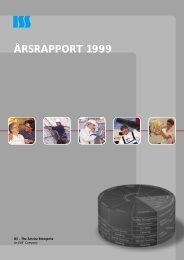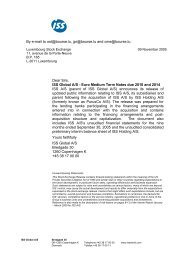Annual Report 2006 ISS Global A/S
Annual Report 2006 ISS Global A/S
Annual Report 2006 ISS Global A/S
You also want an ePaper? Increase the reach of your titles
YUMPU automatically turns print PDFs into web optimized ePapers that Google loves.
NOTES TO THE CONSOLIDATED FINANCIAL STATEMENTS<br />
1 January – 31 December. Amounts in DKK millions<br />
31. Derivatives<br />
<strong>ISS</strong> <strong>Global</strong>'s financial risk management is based on policies approved by the Board of Directors, specifying guidelines and risk limits<br />
for <strong>ISS</strong> <strong>Global</strong>'s financial transaction and positions. <strong>ISS</strong> <strong>Global</strong> may use derivatives to hedge financial risks. Hedging of financial risks<br />
is managed at corporate level.<br />
Currency risk can be classified in three categories: economic, transaction and translation.<br />
In practical terms, the economic currency risk is somewhat limited for <strong>ISS</strong> <strong>Global</strong>, as <strong>ISS</strong> <strong>Global</strong> and its competitors generally have<br />
similar cost structures. However, currency movements may have an adverse effect on the general economic situation of countries in<br />
which <strong>ISS</strong> <strong>Global</strong> operates and <strong>ISS</strong> <strong>Global</strong> may be impacted by such events.<br />
The service industry is characterised by a relatively low level of transaction risk, since the services are produced and delivered in the<br />
same local currency with minimal exposure from imported components. <strong>ISS</strong> <strong>Global</strong>'s transaction risk primarily relates to the payment<br />
of royalties and service fees to <strong>ISS</strong> <strong>Global</strong>, which are made in the local currencies of the paying companies. Thus, a currency risk<br />
exists in relation to the translation of these payments into Danish kroner.<br />
The main currency exposure relates to the risk involved in translating the income statements of foreign subsidiaries into Danish kroner<br />
based on average exchange rates for the year and in relation to the risk of translating the equity in foreign subsidiaries into Danish<br />
kroner based on year-end exchange rates.<br />
<strong>ISS</strong> <strong>Global</strong> may choose to hedge the currency exposure on foreign investments by funding such investments in local currencies or<br />
entering into hedging transactions. As at 31 December <strong>2006</strong>, no such hedging was entered into.<br />
In <strong>2006</strong>, the currencies in which <strong>ISS</strong> <strong>Global</strong>'s revenue was denominated increased with an average of 0.1% (2005: increased with<br />
0.5%) relative to Danish kroner, increasing <strong>ISS</strong> <strong>Global</strong>'s revenue by DKK 58 million (2005: increasing <strong>ISS</strong> <strong>Global</strong>'s revenue by DKK<br />
215 million). Currency movements affected the operating profit by an increase of DKK 3 million (2005: an increase of DKK 16 million).<br />
The effect of the translation of investments in foreign subsidiaries and the effect of hedge transactions, net of tax, decreased equity by<br />
DKK 84 million (2005: increased equity by DKK 101 million).<br />
Interest rate risk is measured by the duration of the net debt. The duration reflects the effect of a simultaneous increase or decrease<br />
in the general level of interest rates for the currencies included in the debt portfolio. As at 31 December <strong>2006</strong>, the duration of net debt<br />
was approximately 4.1 years (31 December 2005: 3.4 years). Thus, all other things being equal, an increase (decrease) of one<br />
percentage point in the relevant interest rates would reduce (increase) the market value of net debt by approximately DKK 740 million<br />
(2005: DKK 542 million). Based on the net debt and taking into account the effect of hedging instruments as at 31 December <strong>2006</strong>, a<br />
general decrease (increase) of one percentage point in relevant interest rates would reduce (increase) the annual net interest expense<br />
by approximately DKK 13 million, all other things being equal.<br />
<strong>ISS</strong> <strong>Global</strong>'s loan portfolio primarily consists of bonds issued under the EMTN-programme and bank loans. A part of the interest<br />
payments on the bank loans have been swapped from floating into fixed rates (see note 25, Long-term debt). To manage the duration<br />
of the net debt, <strong>ISS</strong> <strong>Global</strong> applies derivatives, such as interest rate swaps, futures and options. The deferred gain or loss on the<br />
interest rate instruments will be recognised directly in equity, net of tax. On realisation of the hedged item, value changes recognised<br />
under equity are reversed and recognised together with the hedged item. When a hedging instrument expires or is sold, terminated or<br />
exercised but the hedged future transactions are still expected to occur, the cumulative gain or loss at that point remains in equity and<br />
is recognised in accordance with the above policy when the transaction occurs.<br />
Credit risk represents the risk of the accounting loss that would be recognised if counterparties failed to perform as contracted.<br />
Losses on bad debt relating to individual customers or counterparties have historically been relatively low. <strong>ISS</strong> <strong>Global</strong> performs<br />
ongoing credit evaluations of the financial condition of <strong>ISS</strong> <strong>Global</strong>'s counterparties in order to reduce the credit risk exposure.<br />
Continues<br />
_____________________________________________________________________________________________________________<br />
ANNUAL REPORT <strong>2006</strong> / Consolidated Financial Statements<br />
90



